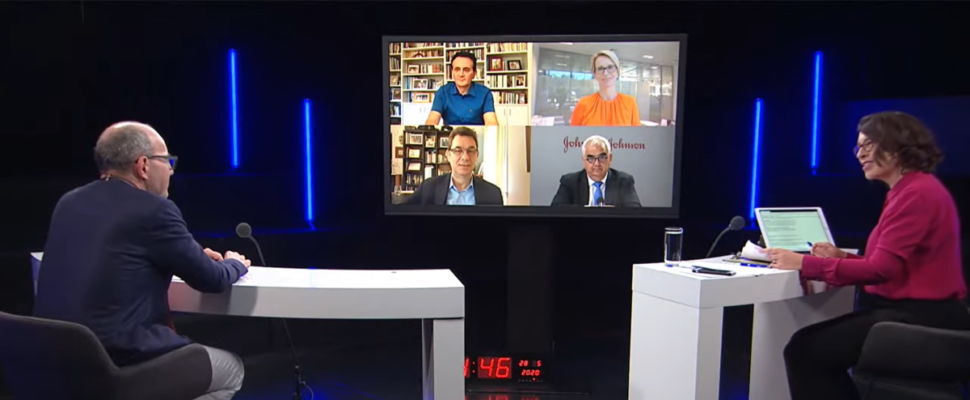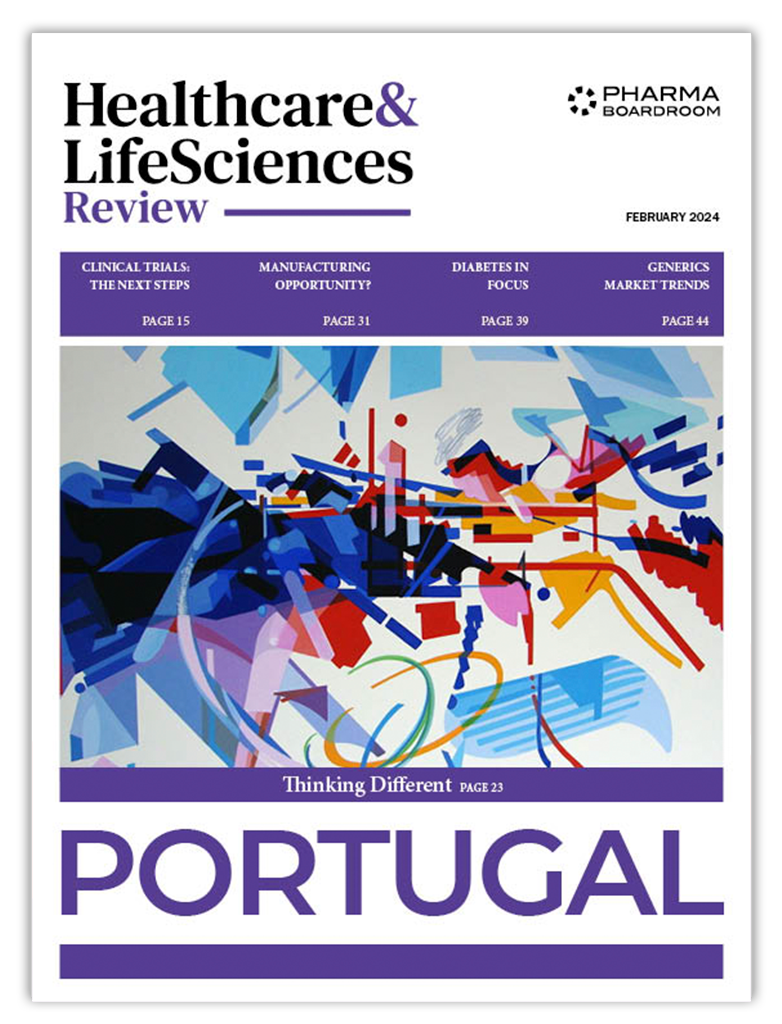During the 28 May 2020 IFPMA media briefing on COVID-19 vaccines, four of the pharmaceutical industry’s leading executives discussed where their firms are in the race to find a vaccine, the unprecedented levels of speed and collaboration being seen, and the challenges that lie ahead. Here we present five of the key points raised.
The Importance of a Healthy (and Profitable) Global Pharma Industry
Pascal Soriot, executive director and CEO of AstraZeneca was keen to underline the clear link between a healthy pharma industry and its ability to move quickly and at scale in times of crisis such as we face today.
I know we are often criticized, but today, hopefully, we can show that the whole industry is stepping up in different ways
Pascal Soriot, AstraZeneca
Noting the massive mobilisation of resources that AstraZeneca has already undertaken, Soriot said “with four bioreactors of 2000 litres each, we are able to make more than one billion doses [of a potential vaccine]. We have a supply chain focused on the US, one in Europe, and we are looking at Asia separately so we can provide this vaccine in a fair and equitable manner to everybody around the world… at no profit.”
Soriot was not alone in promising a billion doses of a potential vaccine in 2021, with GSK CEO Emma Walmsley and Paul Stoffels, vice chairman of the executive committee and chief scientific officer at Johnson and Johnson (J&J) making similar guarantees.
Soriot continued, “This is what a successful, healthy pharmaceutical industry can do. I know we are often criticized, but today, hopefully, we can show that the whole industry is stepping up in different ways… that’s what we can collectively do for our society.”
Egalitarian Access
With rumours swirling in recent months about developed countries being able to access a COVID-19 vaccine before developing nations, GSK’s Walmsley was at pains to highlight the industry’s commitment to ensuring egalitarian access.
“We’ve committed to [manufacturing] a billion doses,” Walmsley stated. “We’ll be manufacturing in Europe, the UK and the US. As data reads out, if we need to get to more, then we’ll make sure that we can do that.”
We need to make sure the route to market and allocation is effective, which is really key to working with forums like ACT, the Gates Foundation, CEPI, and GAVI
Emma Walmsley, GSK
She continued, “The other aspect of thinking about access is making sure that we have responsible pricing and that we learn from this experience… This related to the question of pandemic preparedness and with the multilateral organizations that we’re partnering with, thinking about how we invest in that. That’s why we committed at GSK to invest any kind of short-term return during this period in pandemic preparedness and donations to the countries that need it the most. That means preparedness in terms of rapid scale-up, R&D into new pathogens so we get better detection systems, testing and diagnostics journeys that have been challenging in many countries, but also increasingly vaccine manufacturing capacity.”
“We need to make sure the route to market and allocation is effective, which is really key to working with forums like ACT, the Gates Foundation, CEPI, and GAVI,” Walmsley concluded.
Questioned whether the US population would get the vaccine first, given that AstraZeneca received more than USD one billion from the Biomedical Advanced Research and Development Authority (BARDA), Soriot replied, “I don’t think it’s a question of who is going to get it first. The goal is really to provide it to everybody around the world in an equitable manner. That’s why we have set up independent supply chains… We’ve got an independent supply chain in the US and Europe and in Asia set correctly so we can supply everybody. Essentially what BARDA is doing is placing an advance order for the 300 million doses that they think they need for the US population. We are now holding discussions with CEPI, GAVI, the European community and other governments to do the same everywhere.”
Clinical Trials: Shifting Patient Populations
Throughout March, April and May 2020, Europe has been at the heart of the COVID-19 pandemic. However, with patient populations now decreasing in Europe, J&J’s Stoffels raised the issue of sourcing sufficient numbers of COVID patients for clinical trials in Europe.
Hopefully [clinical trials] can be done in the [global] north. If not, we’ll have to go to the south… the disease is now moving to other parts of the world
Paul Stoffels, J&J
Stoffels said, “We are in place to be able to deliver a billion vaccines next year. With regards to clinical trials, we are planning to start early September, but at the same time, we are working very much in collaboration with the regulators to further accelerate to go through Phase I, II, and III very quickly. We plan to do two large Phase III studies, as typically required in the world to get to full approval.”
He continued, “Hopefully that can be done in the [global] north. If not, we’ll have to go to the south… the disease is now moving to other parts of the world. It will not be over while [disease rates] are getting lower here [in the north] because we have very good control mechanisms and it is summer. It’s clear that in the south, it’s still going up very fast. South Africa, Brazil and maybe other countries will follow.”
AstraZeneca’s Soriot added that “We are running against time because the disease is already declining in Europe… very soon, the disease intensity in Europe will be low and [conducting clinical trials] will become difficult. We have to move very quickly.”
Technology Variations
The four executives also illustrated the diversity of approaches between their firms in the hunt for a vaccine.
GSK has decided to provide its adjuvant technology to a number of partners rather than attempting to develop its own vaccine in house. This is notably the paradigm of the company collaboration with Sanofi. Walmsley pointed out that “clearly, the world is going to need several vaccines. We decided that the best path forward was to offer our unique pandemic adjuvant technology to multiple partners and multiple candidates. This was important because it’s a proven technology in pandemic situations. It is proven also to be safe as well as effective. And critically, it can boost the immune response, and is therefore also antigen sparing so that you can produce more vaccine faster.”
Albert Bourla, chairman and CEO of Pfizer, was in agreement with Walmsley, noting that “there are multiple technologies that are being implemented right now, from very old ones all the way to very novel ones. I hope that they will all be successful because… we will need a lot of options as soon as possible.”
However, Pfizer has chosen to move forward with innovative but as yet unproven Messenger RNA (mRNA) technology for its vaccine. Bourla explains that “The reason why we’ve chosen the mRNA technology, although we have never used it before, it’s the first time that it is used for a vaccine, was because the technology was so far [advanced]. For the past two years we have been collaborating with BioNTech, a German biotech company that is mastering this technology, on a vaccine for flu that has very similar characteristics to COVID-19. Bourla continues, “We felt that we had enough expertise, enough scale, and that the technology was offering speed. With mRNA technology, you can do things in weeks things that with other more conventional technologies, you need months to do.”
There are multiple technologies that are being implemented right now, from very old ones all the way to very novel ones. I hope that they will all be successful because… we will need a lot of options as soon as possible
Albert Bourla, Pfizer
Soriot of AstraZeneca, which is producing its vaccine in collaboration with the University of Oxford, noted that his firm is “looking at monoclonal antibodies. We are testing our BTK inhibitor. We got it within a year, which is used for leukaemia. We’re using it to try and turn off this immune storm that kills people.” He added that “We don’t know which vaccine is going to work. The good thing is that we’re testing different technologies. J&J and AstraZeneca have similar technologies and Pfizer has mRNA. Maybe one, two, or three technologies work and we have a lot of vaccines; that would be good. We have to give it several shots because we don’t know which one is going to work.”
Stoffels adds that J&J, which, like AstraZeneca has received significant funding from BARDA, has been “able to build [its vaccine candidate] on an existing platform. The Ad26 platform where we have also done Ebola, RSV, HIV, ZIKA and Ebola is now very far advanced. So very quickly, we first spent some time on selecting the right vaccine based on the on the right parts of the spike. And we selected the DNA piece with the most immunogenicity.”
Financial Risk
The amount of R&D involved in these megaprojects involves costs running into the billions, as does the manufacturing that will be required to be able to supply any eventual vaccine to an enormous patient population.
Pfizer’s Bourla stated that the cost to what is a USD 1.2 trillion global industry “is going to be a lot of money.” He continued, “I know how much we are investing right now across all initiatives for COVID-19 and the original vaccine is the lion’s share of our investments… [it will be] way in excess of USD two billion. Much of that would be frontloaded, which would be the first year… It is a major undertaking.”
When questioned on how much the industry will potentially waste should COVID-19 disappear shortly, AstraZeneca’s Soriot replied, “I suspect hundreds and hundreds of millions of dollars.” He added, that this waste of finances would be coupled with the waste of “a lot of time spent by hundreds of our colleagues in our companies, people who could be working on other things.”


